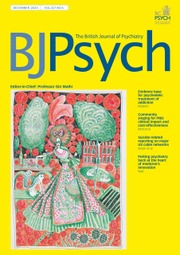Crossref Citations
This article has been cited by the following publications. This list is generated based on data provided by Crossref.
Faigel, Harris C.
1991.
The Effect of Beta Blockade on Stress-Induced Cognitive Dysfunction in Adolescents.
Clinical Pediatrics,
Vol. 30,
Issue. 7,
p.
441.
Nunn, C. M. H.
Stonier, Peter D.
and
Brandon, S.
1992.
Are double‐blind controlled trials always necessary?.
Human Psychopharmacology: Clinical and Experimental,
Vol. 7,
Issue. 1,
p.
55.
Hahn, Philip M.
Van Vugt, Dean A.
and
Reid, Robert L.
1995.
A randomized, placebo-controlled, crossover trial of danazol for the treatment of premenstrual syndrome.
Psychoneuroendocrinology,
Vol. 20,
Issue. 2,
p.
193.
1995.
Treatment of panic disorder with agoraphobia: comparison of fluvoxamine, placebo, and psychological panic management combined with exposure and of exposure in vivo alone.
American Journal of Psychiatry,
Vol. 152,
Issue. 5,
p.
683.
Greil, W.
Ludwig-Mayerhofer, W.
Erazo, N.
Engel, R.R.
Czernik, A.
Giedke, H.
Müller-Oerlinghausen, B.
Osterheider, M.
Rudolf, G.A.E.
Sauer, H.
Tegeler, J.
and
Wetterling, T.
1996.
Comparative efficacy of lithium and amitriptyline in the maintenance treatment of recurrent unipolar depression: a randomised study.
Journal of Affective Disorders,
Vol. 40,
Issue. 3,
p.
179.
Rosman, N.Paul
Douglass, Laurie M.
and
Paolini, Jan L.
2001.
Preventing febrile seizures in children with oral diazepam: Can a controlled trial truly be “double-blind?”.
The Journal of Pediatrics,
Vol. 138,
Issue. 4,
p.
548.
Berent, Stanley
and
Trask, Christine L.
2002.
Handbook of Neurotoxicology.
p.
551.



eLetters
No eLetters have been published for this article.